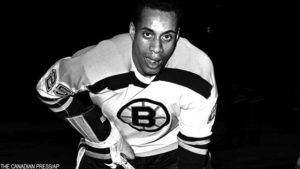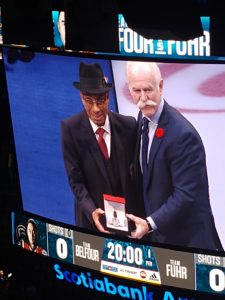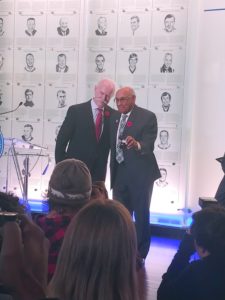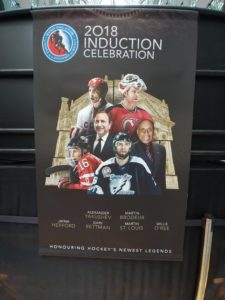Willie O’Ree HOF Induction Proves That Hockey is, Indeed, for Everyone
- Updated: November 12, 2018
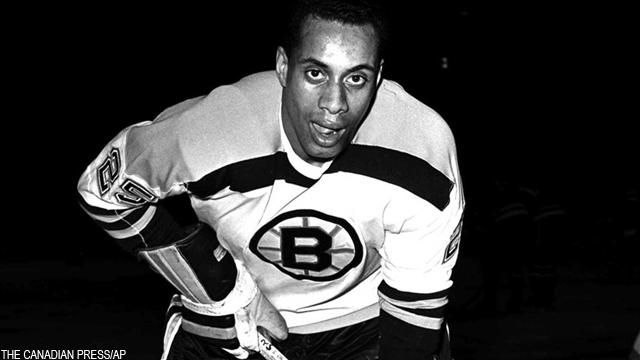
There is arguably no date in hockey history more important than January 18, 1958.
That evening, the Boston Bruins paid a visit to the historic Montreal Forum to shut out the juggernaut Canadiens, winners of nine of their previous 10. As shocking as the end result was, however, there was something far more significant that took place on this night.
Due to an injury, the Bruins needed an extra body — that’s when they called up 22-year-old right-winger Willie O’Ree from the Quebec Aces of the Quebec Hockey League. With that, the NHL’s color barrier was officially broken as Willie O’Ree became the league’s first black player. This was only the beginning of Willie O’Ree‘s long-awaited induction into the Hockey Hall of Fame, which has taken place this weekend in Toronto.
After a two-game stint with the B’s that season, O’Ree was called up three seasons later where he scored four goals and 10 assists. Yet, while his NHL career lasted just 45 games, Willie O’Ree’s impact on the game of hockey would go on to last for generations, opening the door for so many who were denied entry into the sport they loved due to the color of their skin.
Before he would go on to become one of hockey’s greatest ambassadors, though, Willie O’Ree would play 15 more seasons following his NHL career — all of them, with the exception of brief stints in Hull-Ottawa and New Haven, CT, coming in southern California.
O’Ree would go on to become a mainstay in the old Western Hockey League (not to be confused with the current Canadian major-junior league), first playing for the Los Angeles Blades from 1961 to 1967.
The birth of an NHL team in Los Angeles named the Kings — you may have heard of them — meant the end of the Blades. As a result, O’Ree took his career 120 miles south to San Diego where he suited up for the Gulls for seven seasons and the Hawks for another in the short-lived Pacific Hockey League.
Shortly following Friday’s ring ceremony for the inductees in Toronto, I caught up with Mr. O’Ree, now 83, where I asked how much of a difference he saw in hockey’s popularity in California then as opposed to now.
“There’s been leaps and bounds in California when I came and even when [Wayne] Gretzky came [in 1988] and played in Los Angeles,” O’Ree responded. “There were more kids [following Gretzky’s arrival]. There are more rinks [in the L.A. area] that give these kids the opportunity to get on the ice. Some, once, twice a week; some kids, in a nearer rink, get on the ice three, four times a week. But, there are more rinks being constructed now and it just gave the exposure of the game the kids are playing.”
Like Jackie Robinson before him, there may have been debate whether someone else should have broken his sport’s color barrier, but Willie O’Ree has nonetheless paved the way for the likes of Ray Neufeld and Mike Grier, P.K. Subban and Wayne Simmonds. These names are only a small fraction of black players who not only played in the NHL, but who have made their own impact on what is justifiably regarded as the greatest hockey league in the world.
For anyone who’s playing career lasted until age 45, they would be considered a hockey-lifer. Yet, while that was, indeed, the case for Willie O’Ree, his life in hockey was only just beginning when he hung his skates up in 1979.
In 1998, O’Ree was named Director of Youth Development for the NHL/USA Hockey’s Diversity Task Force, which is a non-profit hockey program for minority youths. Since then, O’Ree has traveled North America and the world giving clinics and lectures on the game and specifically to spread the word of the NHL’s ‘Hockey is for Everyone’ program.
Among other accomplishments, Mr. O’Ree was inducted into the New Brunswick Sports Hall of Fame in 1984, named to the Order of New Brunswick and in 2008, named to the Order of Canada. That same year, Willie O’Ree Place was also named in the new Hall-of-Famer’s honour in his hometown of Frederiction.
In Boston, where O’Ree played his NHL career, the accolades continued for the legend.
In 2011, O’Ree received the Hockey Legacy Award from The Sport Museum at the Bruins’ home, the TD Garden. Then, just this year, Willie O’Ree Rink at Boston’s Smith Playground was named for him.
Those who showed their appreciation for the legend, though, stretched all the way to the west coast, specifically in the city he spent the latter part of his career in.
In 2008, O’Ree was presented an award by San Diego State University for Outstanding Commitment to Diversity and Cross-Cultural Understanding. That same year, O’Ree joined the likes of local legends Tony Gwynn, Ted Williams and Tony Hawk in the San Diego Hall of Champions. Even when the new version of the Gulls — the AHL affiliate of the Anaheim Ducks — was reformed in 2015, the club wasted little time in retiring O’Ree’s No. 20.
Some would argue why his induction took so long while others prefer to put a positive spin on the delay, resorting to the adage of being better late than never. On Friday afternoon following the aforementioned ring ceremony in Toronto, Mr. O’Ree addressed the timing of his induction.
“I say some things take a little longer than others,” a modest O’Ree told reporters. “I heard it when I broke the color barrier. They said, ‘You should be in the Hall of Fame for breaking the color barrier,’ though I only played 45 games in the National Hockey League. But, when I got involved with [Hockey is for Everyone] and the places I’ve gone and the year I’ve been involved with it, the people I’ve talked to, the kids I’ve spoken to, then there was the possibility of getting in as a builder.”
Whichever way you look at it, though, Willie O’Ree’s enshrinement into hockey immortality is the proverbial cherry on top to a life in hockey reserved for the few who had the discipline, the patience and the sheer courage to be trailblazers. While this may not have been his motive upon beginning, or even wrapping up, his playing career, Willie O’Ree has nonetheless paved the way for generations of players who were ignored, dismissed or treated with less respect simply due to their skin color.
This weekend, in many respects, is like every weekend in early November. It is a celebration of the hockey’s rich history. 2018, however, only elevates the levels of said celebration.
This past Sunday, having just donned his brand new Hall of Fame blazer, Willie O’Ree was asked what his induction means. His response: “To receive this is the highlight of my life.”
That says it all.
Many have believed that as prestigious as induction into the Hockey Hall of Fame is, the game’s historic venue is flawed without the entry of the man who broke the NHL’s color barrier. That can no longer be said. While it may have been overdue, Mr. O’Ree’s induction into the Hockey Hall of Fame cements the truth that hockey is, indeed, for everyone.
Stay with us at Calisportsnews.com as we will keep you up-to-date on all things NHL and the rest of the LA sports teams! All Cali, All the time

